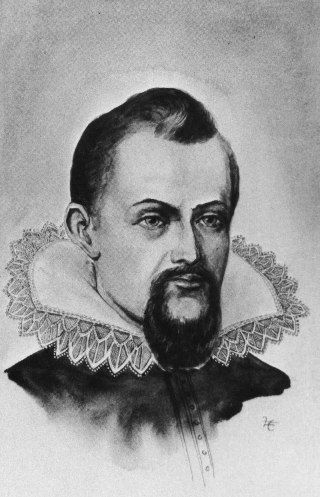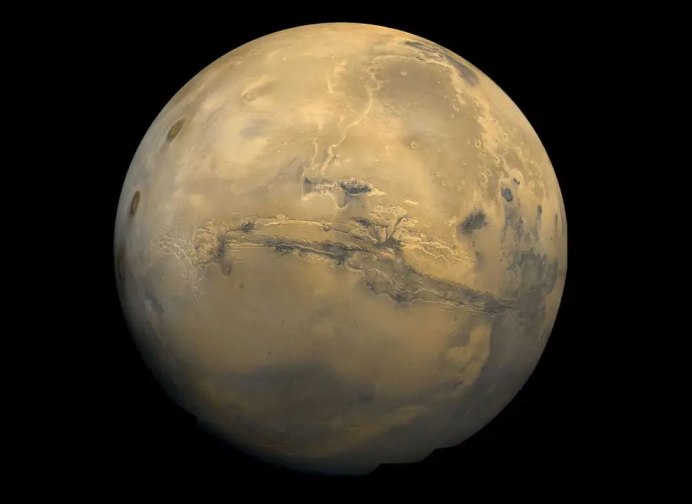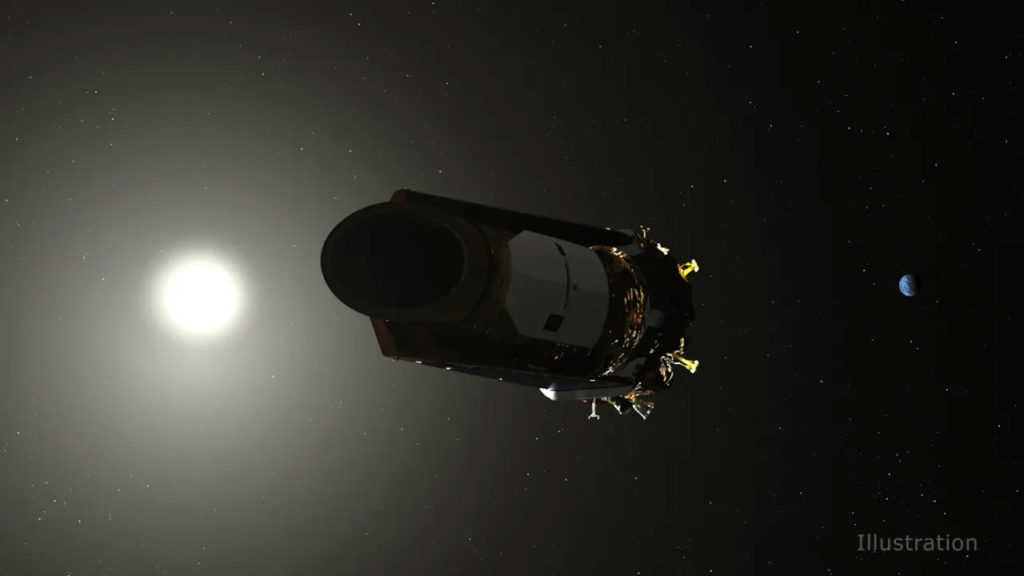The story of how we understand planetary motion would be impossible to tell if not for the work of the German mathematician Johannes Kepler. Kepler’s Three Laws describe how the planets orbit the Sun. They describe 1 – how planets move in elliptical orbits with the Sun as the focus, 2 – a planet covers the same area of space in the same amount of time, regardless of where it is in its orbit, and 3 – the period revolution is proportional to the size of its orbit.
The planets orbit the Sun counterclockwise when viewed from above the Sun’s north pole, and the planets’ orbits are all aligned along what astronomers call the ecliptic plane.
Johannes Kepler was born on December 27, 1571 in Weil der Stadt, Württemberg, which is now in the German state of Baden-Württemberg.
Being a rather weak young man, the exceptionally talented Kepler turned early to mathematics and the study of the sky. When he was six years old, his mother pointed out a comet visible in the night sky. When Kepler was nine years old, one night his father took him under the stars to watch a lunar eclipse. These events made a vivid impression on Kepler’s youthful mind and inspired him to a life devoted to astronomy.
Kepler lived and worked in Graz, Austria, during the turbulent early 17th century. Due to religious and political difficulties typical of the time, Kepler was expelled from Graz on August 2, 1600. Fortunately, he found work as an assistant to the famous Danish astronomer Tycho Brahe (usually referred to by his first name) in Prague. Kepler moved his family from Graz, 300 miles (480 kilometers) across the Danube River, to Tycho’s home. Tycho was a brilliant astronomer. He is credited with making the most accurate astronomical observations of his time, which he accomplished without the aid of a telescope. At a previous meeting he had been impressed by Kepler’s research.
However, some historians believe that Tycho did not trust Kepler, fearing that his talented young trainee might eclipse him as the leading astronomer of his time. Because of this, he only allowed Kepler to see a portion of his vast collection of planetary data.
Quietly commissioned Kepler to understand the orbit of the planet Mars. The motion of Mars was problematic—it did not quite fit the patterns described by the Greek philosopher and scientist Aristotle (384–322 BC) and the Egyptian astronomer Claudius Ptolemy (c. 100–170 AD). Aristotle believed that the Earth is the center of the Universe, and the Sun, Moon, planets and stars revolve around it. Ptolemy developed this concept into a standardized geocentric model (now known as the Ptolemaic system), based on the Earth as a stationary object at the center of the universe.

Johannes Kepler (1571-1630) was a German astronomer best known for identifying three principles of planetary rotation around the Sun, known as Kepler’s laws of planetary motion. Caltech Archive.
Historians believe that one of Tycho’s reasons for passing on the Mars problem to Kepler was Tycho’s hope that it would keep Kepler busy while Tycho worked to perfect his own theory of the solar system. This theory was based on a geocentric model, modified from the Ptolemaic model, in which the planets Mercury, Venus, Mars, Jupiter and Saturn revolve around the Sun, which in turn revolves around the Earth.
As it turned out, Kepler, unlike Tycho, was a firm believer in a model of the solar system known as the heliocentric model, which correctly placed the Sun at its center. It is also known as the Copernican system because it was developed by the astronomer Nicolaus Copernicus (1473–1543). But the reason the orbit of Mars was problematic was because the Copernican system incorrectly assumed that the orbits of the planets were circular.
Like many philosophers of his era, Kepler mystically believed that the circle was the ideal shape of the universe, so he also believed that the orbits of the planets should be circular. For years he struggled to reconcile Tycho’s observations of the motion of Mars with a circular orbit.
Kepler eventually realized that the planets’ orbits were not perfect circles. His brilliant discovery was that the planets move in elongated or flattened circles called ellipses.
The particular difficulties that Tycho encountered in the motion of Mars were due to the fact that its orbit was the most elliptical of the planets about which he had extensive data. Thus, ironically, Tycho unwittingly handed over to Kepler the very part of his data that would allow his assistant to formulate the correct theory of the solar system.

The global mosaic of Mars was created using images from the Viking 1 orbiter taken in February 1980. The mosaic depicts the entire Valles Marineris canyon system extending through the center of Mars. It is more than 2,000 miles (3,000 kilometers) long, 370 miles (600 kilometers) wide, and 5 miles (8 kilometers) deep. NASA
Since the orbits of the planets are ellipses, it would be useful to consider three basic properties of the ellipse:
An ellipse is defined by two points, each of which is called a focus, and together called foci. The sum of the distances to the foci from any point of the ellipse is always constant.
The degree to which an ellipse is flattened is called eccentricity. The flatter the ellipse, the more eccentric it is. Each ellipse has an eccentricity ranging from zero (a circle) to one (essentially a flat line, technically called a parabola).
The longest axis of the ellipse is called the major axis, and the shortest axis is called the minor axis. Half of the major axis is called the semimajor axis.
Having established that the orbits of the planets are elliptical, Kepler formulated three laws of planetary motion that accurately described the motion of comets.
In 1609, Kepler published New Astronomy, which explained what are now called Kepler’s first two laws of planetary motion. Kepler noticed that an imaginary line drawn from a planet to the Sun covered an equal area of space in equal time, regardless of where the planet was in its orbit. If you draw a triangle from the Sun to the position of a planet at a certain moment in time and its position at a certain moment later, the area of that triangle will always be the same, at any point in the orbit.
For all these triangles to have the same area, the planet must move faster when it is near the Sun and slower when it is further from the Sun. This discovery became Kepler’s second law of orbital motion and led to the implementation of what became Kepler’s first law: planets move in an ellipse with the off-center Sun at one focal point.
In 1619, Kepler published Harmonics of the Universe, in which he described his “third law.” The third law shows that there is a precise mathematical relationship between a planet’s distance from the Sun and the time it takes to orbit the Sun.
Here are Kepler’s three laws:
Kepler’s First Law: Every planet’s orbit around the Sun is an ellipse. The center of the Sun is always located at one of the foci of the ellipse. The planet moves in its orbit in an ellipse, which means that the distance from the planet to the Sun is constantly changing as the planet moves through its orbit.
Kepler’s Second Law: An imaginary line connecting a planet and the Sun spans—or covers—equal areas of space for equal intervals of time as the planet rotates. Essentially, planets do not move in their orbits at a constant speed. Instead, their speed varies so that the line connecting the centers of the Sun and the planet covers an equal area in equal periods of time. The point of closest approach of a planet to the Sun is called perihelion. The point of greatest separation is aphelion, therefore, according to Kepler’s second law, a planet moves fastest when it is at perihelion and slowest at aphelion.
Kepler’s Third Law: The squared period of a planet’s revolution is directly proportional to the semimajor axes of its orbit cubed. This is written in equation form as p 2 =a 3 . Kepler’s third law implies that a planet’s orbital period around the Sun increases rapidly as the radius of its orbit increases. Mercury, the innermost planet, orbits the Sun in just 88 days. It takes Earth 365 days and distant Saturn 10,759 days to do the same.
Kepler didn’t know about gravity, which is responsible for keeping planets in orbit around the Sun, when he came up with his three laws. But Kepler’s laws played an important role in Isaac Newton’s development of his theory of universal gravitation, which explained the unknown force behind Kepler’s third law. Kepler and his theories played a critical role in understanding the dynamics of the solar system and served as a springboard for new theories that more accurately approximate planetary orbits. However, his third law only applies to objects in our solar system.
Newton’s version of Kepler’s third law allows us to calculate the masses of any two objects in space if we know the distance between them and the time they take to orbit each other (their orbital period). Newton realized that the orbits of objects in space depended on their masses, which led him to the discovery of gravity.
Newton’s generalized version of Kepler’s third law underlies most of the measurements we can make today of the masses of distant objects in space. These applications include determining the masses of moons orbiting planets, stars orbiting each other, black hole masses (using nearby stars that are affected by their gravity), exoplanet masses (planets orbiting stars other than our Sun) , as well as the existence of mysterious dark matter in our galaxy and others.

NASA’s Kepler Space Telescope has discovered thousands of planets beyond our solar system and revealed that there are more planets than stars in our galaxy. NASA
In planning the trajectories (or flight plans) of spacecraft and in measuring the masses of moons and planets, modern scientists often go one step further than Newton. They take into account factors related to Albert Einstein’s theory of relativity, which is necessary to achieve the precision required for modern scientific measurements and spaceflight.
However, Newton’s laws are still accurate enough for many applications, and Kepler’s laws remain an excellent guide to understanding how the planets move in our solar system.
Johannes Kepler died on November 15, 1630 at the age of 58. NASA’s Kepler space telescope was named in his honor. The spacecraft launched on March 6, 2009, and spent nine years searching for Earth-like planets orbiting other stars in our region of the Milky Way. The Kepler Space Telescope has made a legacy of more than 2,600 discoveries of planets beyond our solar system, many of which may be promising places for life.




